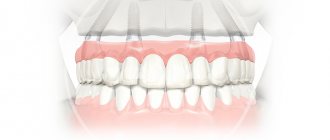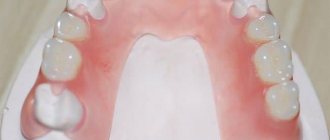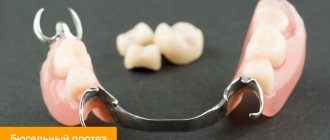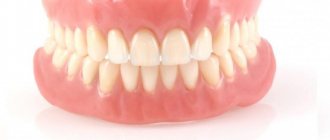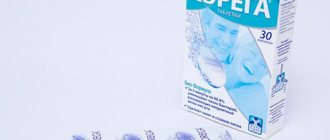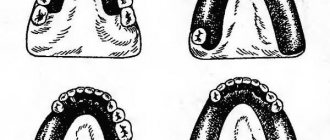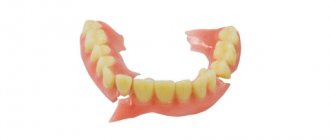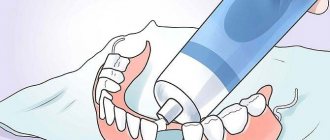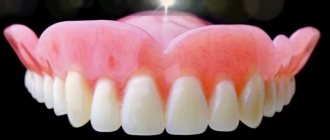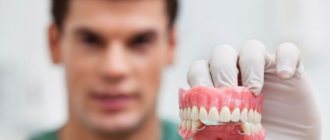Removable dental bridges and dentures are in great demand due to their affordable cost. Removable dentures are used for complete or partial loss of teeth, as well as as a temporary solution until a fixed structure is installed.
It should be noted that modern prosthetics are very different from the bulky and uncomfortable products of the last century. Now they look more aesthetically pleasing, have a natural appearance, fit tightly to the gums and are securely fixed.
Indications for removable prosthetics can also be inflammation of the gums, bone deficiency, or contraindications to the installation of dental implants.
Installation Features
Removable structures have a base that imitates natural gums. Therefore, they look natural, like natural teeth.
In case of complete edentia, the removable denture is attached directly to the gums. The prosthesis fits tightly to the soft tissues, without displacement or loosening.
The prosthesis is fixed using clasps, hooks or implants. The lower part is attached to the roots of the natural teeth, and the upper part is attached inside the base of the structure. If the prosthesis replaces the entire dentition, then fixation occurs only on the gums.
Push-button ball mount
The essence of this fastening is that the shape of the artificial tooth installed on the implant has an unusual appearance. Such a tooth is made in the form of a column, the thickened top of which has a spherical shape. At the same time, the column itself simultaneously serves as part of the lock. The second part of the lock (attachment) is located directly on the prosthesis. At the base of the prosthesis, depressions are made, located exactly above the “balls” of the supporting crowns of the implants. When putting on the prosthesis, the lock snaps into place.
Alas, such fastening is not reliable. The reason for this is that when chewing hard food, the “balls” on the crowns of the implants sometimes break. Repairing crowns is not an easy task and is not always quick.
Types of removable dentures
Dentures for complete absence of teeth
These removable dentures are a lightweight, curved plastic plate that covers the entire jaw and palate (if used on the upper jaw). Artificial teeth (made of plastic or porcelain) are attached to it. The removable bridge is fixed due to the natural suction effect of the gums. The use of removable structures is possible only in the case of complete edentia (loss of all teeth).
Conditionally removable orthopedic prostheses
Such removable dentures can be used in case of loss of single teeth (for example, chewing teeth) or in case of significant violations of the integrity of the dentition (loss of a group of teeth). These orthopedic elements can also act as temporary structures. To fix them on natural teeth, special locks (clasps) are used. The component is made of durable metal, which ensures its reliable installation.
It is important to understand that not all partial denture materials are suitable for restoring teeth in the smile area. Therefore, in the case of restoration of the front teeth, it is better to choose removable dentures on implants.
Lamellar
This type of plate dentures is most often used in cases of loss of chewing teeth. This is one of the simplest and most affordable removable dentures.
Removable sectors or segments.
They are unilateral partially removable dentures used when several chewing teeth are lost in a row on one side of the jaw.
Immediate dentures
This is a temporary structure. This product is designed to hold adjacent teeth in place and protect gums until a permanent denture or crown is fabricated. Externally, an immediate denture looks like an ordinary tooth, but on the sides it has special clippers in the form of wings, with the help of which it is secured to the gum. Thanks to these fastenings, it received its second name - “butterfly”
Prostheses made from Acri-Free material
Acry-free material is made from acrylic resins mixed with polymers. The result is a substance that, in its physical and chemical properties, is in the middle between plastic and nylon. The material is not as brittle as plastic, but not as flexible either. A prosthesis made from acry-free cannot be adjusted.
The base of the prosthesis is made by hot pressing acry-free granules. The compression of the granules is so strong that absolute polymerization occurs and monomers cannot penetrate into the structure of the material.
It is also noteworthy that these dentures do not use metal clasps, but dentoalvelar ones. Thanks to this, the aesthetics of such prostheses is much higher. In what cases are acry-free prostheses used:
- when restoring lost teeth or the entire dentition;
- if the patient has bruxism (involuntary grinding of teeth);
- if the patient has periodontal disease or increased sensitivity of the soft tissues of the oral cavity;
- if the patient has an allergic reaction to plastic.
Acry-free removable dentures have the following advantages:
- they do not cause an allergic reaction;
- the material is absolutely clean in terms of environmental friendliness;
- there is no need to trim supporting healthy oak trees;
- high strength of the material and durability of the prosthesis;
- the material is easy to process;
- the ability to install dentures in the presence of diseases in the oral cavity;
- There are no restrictions in the selection of colors, because the prosthesis is translucent.
Modern materials
Removable acrylic dentures
Budget option based on polymers. Conventional plastic dentures strongly rub the gums and do not fit well. However, our laboratory specialists use a special formula - a new generation acrylic prosthesis, with the addition of crushed diamond chips. The design is more resistant to chewing loads, comfortable to wear and has an aesthetic appearance, and also provides a longer service life.
Elastic
These can be soft nylon or thin removable dentures made of acrylic resins (Acry Free). The material adheres tightly to the gum tissue in the oral cavity. Does not cause pain or discomfort. Can be used for bruxism.
Who is suitable for nylon prostheses?
The use of removable nylon dentures is acceptable in the absence of one or several teeth. The products are used in cases of lack of extreme, lateral or front teeth in a row and even in cases of complete edentia. Edentia is commonly understood as the absence of all teeth in a row or jaw. The use of removable dentures made of nylon is possible for sensitive and weak gums, as well as for restoring dentition in children. Such orthopedic products do not contain metal compounds and are excellent for patients with allergic reactions. As for nylon itself, it is absolutely hypoallergenic.
With locks (sandwich dentures)
Installation requires two healthy tooth roots. One part of the lock is attached to the dental bridge, the second (abutment) is fixed in the root of the tooth. The prosthesis does not have a septum in the palate, which ensures maximum taste sensitivity. Thanks to the partial overlap, the removable denture can be worn for several days, only being removed for cleaning.
Dentures on implants
The most popular type of prosthesis. It is securely attached to the gum due to four supports connected to each other by a beam. Removable dentures on implants provide an even load on the jawbone, and the absence of a palate in the structure guarantees a natural taste perception when eating. It is easy to use, has a long service life and can be easily replaced with a new one if necessary. The only drawback is the high cost of installation due to the materials used. However, the price is fully justified by the quality, comfort and durability of the product.
Clasp dentures
This type of prosthesis is suitable for complete and partial restorations. Due to its aesthetics and affordable price, removable clasp dentures are in high demand among patients in dental clinics.
When making a removable clasp denture, specialists use a base made of elastic plastic, to which a metal beam is attached. Dental crowns made of artificial materials are fixed on the latter. Depending on the type of structure and the wishes of the patient, crowns on a dental bridge can be made of plastic, metal or metal-ceramics.
A partially removable denture is attached using clasp hooks if there are native supporting teeth. Or it could be a hidden mechanism that connects the crown to the base of the tooth. The clasp bridge is easy to use - it does not need to be removed before going to bed.
Indications and contraindications
Prosthetics has some contraindications that you should pay attention to:
- When installing implants, problems with anesthesia may arise in patients who, for a number of reasons, cannot tolerate pain relief.
- Oncological diseases and diabetes (especially important for patients who are dependent on insulin therapy).
It is worth paying attention to a possible relative contraindication, manifested in the form of infectious diseases of the mucous membranes, including the oral mucosa. A low blood clotting coefficient is also a contraindication to the installation of removable structures.
Peculiarities
The algorithm for prosthetics of the upper and lower jaws is different.
It is easier to install the structure on the upper dentition, since there are more support points. If in the lower jaw the removable denture rests solely on the gums (in the absence of implants), then in the upper jaw - on the gums and palate. The upper denture distributes the load more evenly. Thus, even complete edentia is not a death sentence, and the false jaw will not move while eating. The upper prosthesis is made of nylon or acrylic, depending on the wishes of the patient.
The lower jaw requires a more careful selection of the design and its manufacture will pose some difficulties for the dental technician. The base does not have so many support points, the mucous membranes have a large area, but it is collected in folds, the lingual frenulum also prevents reliable fixation of the prosthesis using clasps. Dentists often suggest installing partial removable dentures on the lower jaw, but this type of prosthetics is possible if there are at least 1-2 healthy teeth in a row. If there are none, the doctor will recommend installing titanium pins.
Complete edentia of both rows does not oblige you to place a prosthesis made of the same material on both jaws. The dentist will definitely select those designs that will not only be comfortable for you, but also functional.
Manufacturing stages and installation
Before installing removable dentures in the absence of teeth, the dentist must refer the patient for a full medical examination. The doctor examines the oral cavity and identifies possible contraindications. If no absolute prohibitions are found, the doctor prescribes therapy to eliminate relative contraindications and then proceeds to prosthetics.
If the prosthetic bed is of normal size and the alveolar processes are able to withstand the load and become a support for the structure, the dentist helps the patient decide on the choice of prosthesis. Further actions of the doctor:
- Taking impressions of the jaw.
- Casting the model.
- Formation of the basis.
- Determination using impressions of the central bite.
- Modeling of a prosthetic structure with all aesthetic nuances (shape, color, relief).
This is followed by fitting of the structure to the patient, final corrections and installation.
Care and service life
Removable dentures take some getting used to. The adaptation period lasts about 1 month. It is important during this period not to try to spend a lot of time without the structure, as this will increase the adaptation time. In addition, you should not load the prosthesis by grinding hard and tough foods: for the first 2-3 days, eat liquid food and cereals.
Main rules of care:
- cleaning (each meal should be accompanied by cleaning or rinsing the structure);
- You should not store the prosthesis near hot objects, since the elevated temperature causes the material to deform and the structure becomes unusable.
Important! We do not recommend taking long breaks from wearing a prosthesis. The absence of it in the mouth for 1-2 weeks leads to initial discomfort and addiction. Proper care of the prosthesis guarantees an extension of its service life to 5-7 years.
Price
Prices for removable dentures for complete absence of teeth vary within:
- 19 thousand rubles for a removable acrylic denture for one jaw;
- 30 thousand rubles for a nylon structure.
A clasp prosthesis will cost you 35 thousand for clasp fixation and from 80,000 for a prosthesis with micro-locks.
The MY ORT clinic specializes in installing removable dentures from any material. To clarify all the details, make an appointment with our dentist for the first time. Call: +7 (812) 989-13-49.
Fastening methods
For complete restoration of the dentition, a spherical or beam method of fastening is used. The first method is used only for fixing 1-2 implants, due to the mobility of the fasteners. A removable denture on a bar provides a strong and reliable fastening of the structure in the mouth. Does not move when talking or eating. Due to the high precision of installation, the patient’s natural bite is restored.
There is a third, screw method: A removable denture is attached directly to implants installed in the bone tissue. Advantages of the method: maximum accuracy of installation, uniform distribution of load on the jaw, high aesthetics.
Caring for removable dentures (clean them correctly)
Cleaning dentures is not something onerous, but there are certain rules that must always be followed. Removable dentures must first be rinsed under a tight stream of hot water, and then cleaned with toothpaste. True, you can only use soft brushes.
There is another way to clean dentures. Pharmacies now sell special tablets with a high content of active oxygen. This tablet needs to be dissolved in a cup of water, and then dentures washed with hot water should be placed in it. After 2-3 minutes, all bacteria on the dentures will die.
Fitting and installation
The installation process will take only 2-3 days, and will require 3 visits to the doctor.
The initial stage includes a primary diagnosis of the oral cavity, the condition of the teeth and gums, as well as taking an impression. The production of a removable denture will take from 3 to 14 days, depending on the type of design chosen.
At the stage of installing a removable denture, it is important to assess the level of comfort when wearing it. It is important that the patient does not experience pain during fitting and does not rub the gums.
At the final stage, the doctor secures the prosthesis with clasps and tells the patient how to use and care for it.
In the case of implants with bar fasteners, support rods are first fixed in the jaw tissue. A short break will be required for implantation. After this, a completely removable denture is installed.
If the patient does not have the opportunity to undergo a rehabilitation period, an alternative may be implantation technology with immediate loading. In this case, tooth restoration takes 1-2 days.
With proper use, a removable denture will last you 7-10 years. If damage occurs, it can be repaired, but if the base is damaged or the dental crowns are severely deformed, then our experts recommend replacing the denture with a new one to eliminate the risk of injury to the oral cavity and infection.
Laboratory stage
The impression obtained in the clinic is transferred to the laboratory to the dental technician. Such laboratories have everything necessary for the manufacture of removable dentures. The impression is a matrix from which the dentist casts a wax model of the future prosthesis. This work is done on a special device, an articular. It allows you to keep impressions of the upper and lower dentition at a given distance from each other. Moreover, the articulation can even imitate the movement of the jaws.
The wax beads are then removed from the articulation and the technician uses them to create an acrylic prosthesis. This product is sent back to the dentist, who tries it on for the patient. This process is called fitting. At this time, the doctor compares the color of acrylic teeth with the color of the patient’s natural teeth, of course, if he has any. If no differences are found, the doctor again hands the product over to the technician. He then makes a natural removable denture, which will be installed.
While wearing a denture, some changes appear in the oral cavity. In particular, due to atrophy, the pattern of the mucous membrane of the palate changes. In addition, due to the reduced mechanical load, the volume of the jaw bone tissue decreases. As a result, the prosthesis begins to loosen after a few years, although its integrity is maintained. In this case, you have to make a new impression and use it to build up material onto the surface of the prosthesis body. This process in dentistry is called relining or correction.
Advantages of removable dentures
Installing a denture helps restore the aesthetics of the dentition. However, this is not its main function. Missing teeth leads to a number of problems: poor digestion, displacement of existing teeth, asymmetry of the facial muscles and difficulties with diction.
Removable prosthetics is an affordable method that helps solve the problem of complete or partial edentia.
Modern dentures are hypoallergenic and safe. High-quality materials allow us to develop durable structures with strong fixation in the oral cavity.
Nylon or silicone dentures
This type of prosthesis is similar to acrylic, but made from more modern and safe materials. Nylon is softer and more elastic, the prosthesis looks better than acrylic ones, but they are also fixed - not quite reliably. Due to the softness of the system, these dentures will not allow you to chew food well; in addition, they load the gums in this way, which over time leads to atrophy of the jaw bone tissue.
Nylon dentures have the following advantages: the absence of allergic reactions, due to the absence of pores in the material, they do not absorb moisture and odors, getting used to them is faster than acrylic ones, they do not rub the gums, are practically invisible to others and have antimicrobial properties.
The disadvantages include: uneven load distribution, short lifespan (3-4 years) and impossibility of repair, high price compared to acrylic ones. Another disadvantage is the problem of a massive base, which, covering the entire palate, causes problems with diction. The elasticity of the nylon prosthesis material is also its disadvantage. Due to the flexible base, the load during chewing is transferred only to the area where food is currently being chewed, this leads to accelerated atrophy of bone tissue.
Care
Cleaning a removable denture is not much different from cleaning natural teeth. Although it has its own characteristics.
After each meal, it is recommended to rinse them thoroughly with water. This will prevent bacteria and infection from entering the gums.
It is better to clean it with professional products suitable for its material. If the structure is completely removable, it is recommended to leave it in a disinfectant solution before going to bed.
Periodically check the denture for cracks and chips. If any damage is found, consult a doctor immediately.
For preventive purposes, it is important to visit the dentist at least once every six months. The specialist will conduct a professional examination, check the condition of the jaw and gum tissue, and also clean the dental bridge from contamination.
Types of clasp dentures
Let's look at the different types of clasp prosthetics used in the Dentalika clinic.
The clasp clasp prosthesis is held in place using hooks (clasps) that tightly cover the tooth but do not harm the enamel (see picture):
Clasp prosthesis with locking fixation - the fixing element is hidden inside the prosthesis, and therefore, even with a wide smile, the removable structure is absolutely invisible:
Clasp prosthesis on telescopic crowns - is held on the tooth using a crown consisting of two parts: the first part is a removable metal-ceramic crown, the second is a metal cap with parallel walls, cemented to the tooth. The crowns fit one on top of the other, tightly fixing, the prosthesis is comfortable and is not perceived as removable.
Caring for a clasp prosthesis is simple: in the evening you need to remove and clean the prosthesis. You don’t have to remove the prosthesis at night, which is quite comfortable psychologically.
The clasp denture is a technologically complex design, which leads to the need for mandatory periodic monitoring by your attending physician in order to monitor the inevitable “gum shrinkage” under the prosthetic bed (to avoid the appearance of voids there) and the load on the supporting teeth. If necessary, relining (layering of plastic) of the prosthesis is carried out.
We recommend that our patients pay attention to full and partial removable dentures ACRI-FRI (see pictures) and Vertex , which have proven themselves in the practice of our clinic.
Alternative solutions
Atrophy of the jaw tissue becomes a serious argument in favor of fixed prosthetics. In the case of complete adentia due to bone deficiency, the optimal solution is immediate implantation, with fixation of the prosthesis for 2-3 days.
This technology includes All-on-4 and All-on-6 punctures. For installation, 4 and 6 dental implants are used, depending on the condition of the bone tissue. This technology allows you to fix a removable denture immediately after installing the implants.
Titanium rods are almost completely fused with the jaw bone. The prosthesis is tightly fixed to the implants, without the risk of displacement, and it can be loaded immediately after its installation.
The operation includes several stages:
- Initial examination, hardware diagnostics using 3D modeling technology.
- Preparing the jaw for implantation - removing decayed teeth, choosing a site for installing implants.
- Fixation of titanium rods in a gentle manner, with minimal surgical intervention (without deep incisions).
EspaDent's own dental laboratory allows us to produce a removable dental prosthesis in the shortest possible time, without loss of quality or extra costs.
Classification
It should be noted that in dentistry, removable dentures are divided into the following groups:
- Complete removable plate dentures;
- Partial removable dentures, which, in turn, are: plate dentures;
- immediate dentures;
- clasp dentures.
Complete removable dentures are used when it is necessary to restore completely missing teeth and are often the only alternative to prosthetics in the complete absence of teeth in both or one of the jaws. In this case, the full denture is attached due to the suction effect of the gums. An example of complete removable dentures is shown in the figure on the left.
Such dentures are made from imported dental acrylic plastics using the following methods:
- injection molding method;
- hot cold compression polymerization method;
- by cold compression polymerization.
Modern technologies make it possible to create dentures that vary in color, shape and size of teeth, depending on the individual characteristics and needs (wishes) of each patient.
We especially emphasize that artificial teeth have very high wear resistance and good aesthetic qualities. With proper use and good hygiene, they do not change their appearance, color, density for a very long time and can serve for a long time.
Complete removable dentures, as well as other removable orthopedic products, are quite acceptable to leave in the mouth overnight after evening hygiene procedures. If the owner of a removable orthopedic structure wants to take a break from the prosthesis while sleeping, then after hygienic cleaning, wipe it dry and, wrapped in a napkin or handkerchief, leave it until the morning.
Partial removable dentures are applicable in the following cases:
- in the absence of one tooth;
- in the absence of a number of teeth in one row;
- in the absence of chewing teeth;
- as a temporary prosthesis.
Thus, this type of removable dentures is often prescribed for the loss of the main chewing teeth, the presence of terminal defects in the dentition, when it is not possible to use adjacent teeth as a support for the bridge due to their absence or loosening in the jaw bone, and long-term defects in the dentition.
Partial removable dentures, as I already said, are divided into:
- plate prostheses;
- immediate dentures;
- clasp dentures.
Acrylic plate dentures are used to restore a lost fragment of the dentition when the patient has few teeth left in the mouth or the remaining teeth are unreliable, which does not allow them to be used for prosthetics with fixed prostheses (crowns and bridges). The advantage of this type of prosthetics is its simplicity and affordability. Dentures made of acrylic plastic correctly distribute the load on the gums and allow full chewing. An example of partial plate removable prosthetics is shown in the figure:
It should be noted that the main disadvantage of this type of prosthetics is that the fixation of the prosthesis is not rigid enough, which leads to the need to frequently activate the clasps (tighten the hooks).
Immediate dentures are a temporary structure that is applied to the jaw immediately after tooth extraction or in preparation for prosthetics with a permanent denture. The goal of immediate prosthetics is to prevent teeth from moving and to keep them in place. Prosthetics with these removable dentures are short-lived and long-term use is not recommended. The figure shows an option for replacing a defect in a central tooth using an immediate prosthesis:
The adaptation period for plate dentures proceeds as follows: at first, of course, the sensations are quite unpleasant. The new design is foreign, intrusive, and may give the impression that there is very little room for the tongue. The main thing is not to be nervous - everyone without exception goes through these sensations. It’s hard to believe, but in a week or two or three you will already forget that the teeth are “not your own.” There are several phases of addiction:
- irritation (usually up to a day);
- partial inhibition (days 1-5, when chewing function and speech are gradually restored);
- complete inhibition (5-33 days, when you already begin to experience discomfort without a prosthesis).
The first thing you may encounter is a gag reflex to the prosthesis and increased salivation. The body’s normal reaction to a foreign object goes away on its own; psychotherapy and sucking on lollipops will help alleviate the condition.
At first, usually, marks form on the gums, so you have to grind the prosthesis. This is also absolutely normal, because a dense plaster model cannot perfectly replicate pliable living tissue. You need to adjust as many times as necessary. The same goes for rubbing or biting your cheek or tongue.
Over time, as a rule, the denture begins to fit less tightly and “walk” when chewing. This is a consequence of subsidence of the gums, or rather the jaw bone, which changes due to the absence of its own teeth. This is also quite easily corrected by adding plastic ( relining ) - this is a manipulation carried out in the patient’s mouth or in a laboratory way in the laboratory. The fact is that while wearing a removable denture under the base of the removable denture (the base is the part of the denture that is in direct contact with the oral mucosa), atrophy of the mucous and bone tissue occurs. As a result, a void appears between the prosthesis and the mucous membrane, and the prosthesis no longer fits tightly. To eliminate this discomfort, the prosthesis is relined, plastic is placed in place of the void formed due to atrophy, and a tight fit of the prosthesis is restored.
Let's consider clasp prosthetics as the most comfortable and at the same time complex design. The clasp prosthesis consists of several elements: a metal frame, including an arch (clasp) and fixing elements, as well as a saddle-shaped part with artificial gum on which artificial teeth are located.
This is the most reliable, convenient, but more expensive design. Its main difference and advantage is that the chewing load is distributed evenly between the gingival surface of the jaw and the remaining teeth, in contrast to partial plate dentures, where the entire load falls on the gum. In the manufacture of such prostheses, accurate calculations and modeling of all elements of the prosthesis are performed. Also, the clasp prosthesis is used as an immobilizing, splinting for periodontal disease and increased tooth mobility. Removable dental prosthetics using a clasp allows you to restore any areas of the teeth without creating discomfort, which is very important for the patient. This reduces the time it takes to get used to the prosthesis, phonetic disturbances are reduced to a minimum and disappear in the first stages of adaptation.
Examples of prostheses made in our laboratory
Thermoplastic (clasp) "Quattroti".
ACRY FREE (acrylic free).
Nylon removable denture.
The article was checked by: Meleshkin Dmitry Vladimirovich
If you liked this post, share it with your friends and subscribers.
